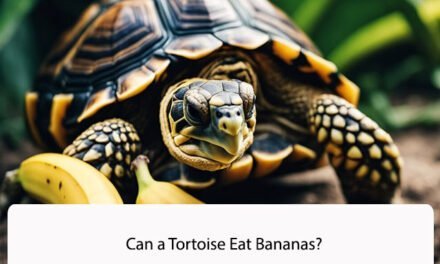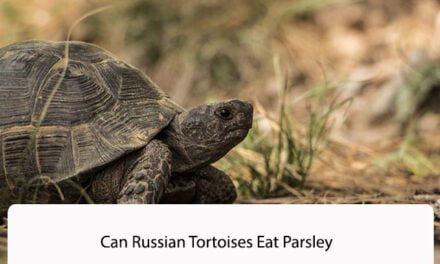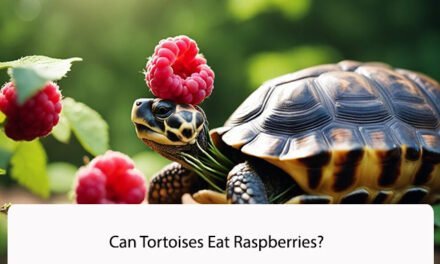Tortoises are fascinating creatures that make great pets. They are herbivores and enjoy a variety of fruits and vegetables. One question that often comes up is whether or not tortoises can eat pumpkin.
The short answer is yes, tortoises can eat pumpkin. In fact, pumpkin is a nutritious food that is high in fiber and vitamins. However, it is important to prepare the pumpkin properly and feed it in moderation.
When feeding pumpkin to your tortoise, make sure to remove the seeds and skin. The seeds can be a choking hazard, and the skin is difficult for them to digest. Cut the pumpkin into small pieces and offer it as a treat alongside their regular diet. As with any new food, it is important to introduce pumpkin slowly and monitor your tortoise for any adverse reactions.
Understanding Tortoises’ Diet
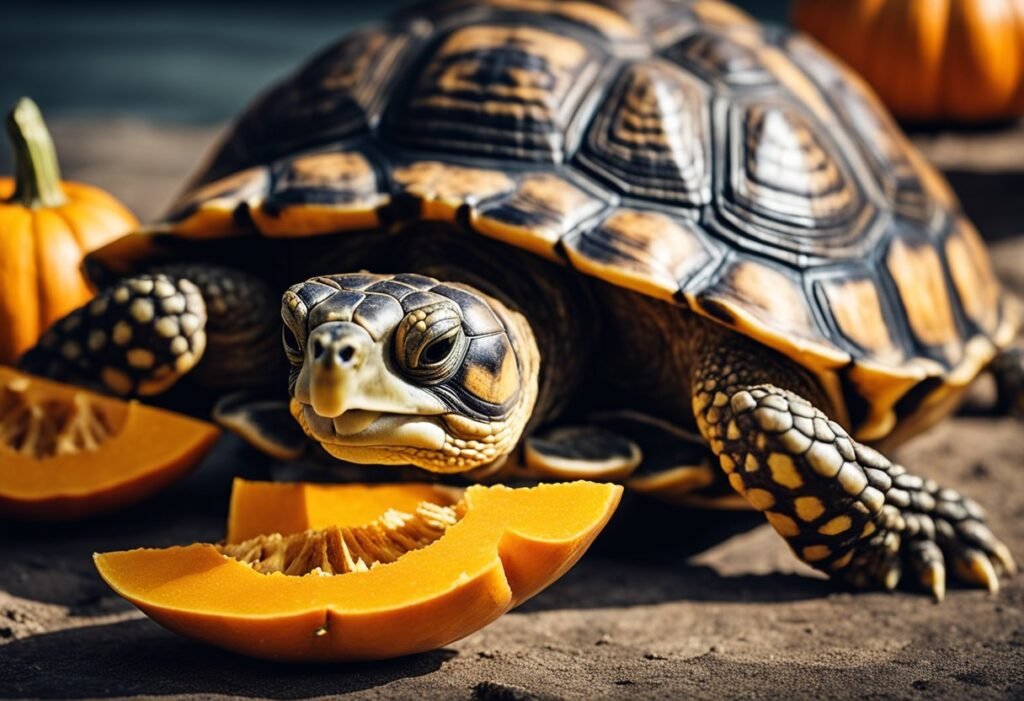
Tortoises are herbivorous reptiles that require a specific diet to remain healthy. In the wild, they consume a variety of plant matter, including grasses, weeds, and flowers. As a responsible pet owner, it’s essential to understand your tortoise’s dietary needs to ensure they receive proper nutrition.
General Dietary Habits
Tortoises have a slow metabolism, which means they require a low-calorie diet. They also have a unique digestive system that is designed to break down tough plant matter. Therefore, their diet should consist of a variety of high-fiber plants, such as leafy greens, vegetables, and fruits.
It’s important to note that not all plants are safe for tortoises to consume. Some plants, such as avocado and rhubarb, are toxic and can cause serious health problems. Therefore, it’s crucial to research and consult with a veterinarian to determine which plants are safe for your tortoise to eat.
Nutritional Requirements
Tortoises require a balanced diet that includes a variety of nutrients, including fiber, protein, calcium, and vitamins. Calcium is especially important for tortoises, as it helps maintain healthy bones and prevents metabolic bone disease.
To ensure your tortoise receives proper nutrition, it’s recommended to offer a variety of plant matter. Here are some examples of nutritious foods that tortoises can eat:
- Leafy greens: kale, collard greens, dandelion greens, and mustard greens
- Vegetables: carrots, squash, bell peppers, and green beans
- Fruits: strawberries, raspberries, and watermelon
- Supplements: calcium and vitamin D3
In conclusion, understanding your tortoise’s dietary needs is essential to their health and well-being. By providing a balanced diet that includes a variety of nutritious plant matter, you can help ensure your tortoise lives a long and healthy life.
Pumpkin as a Food Source
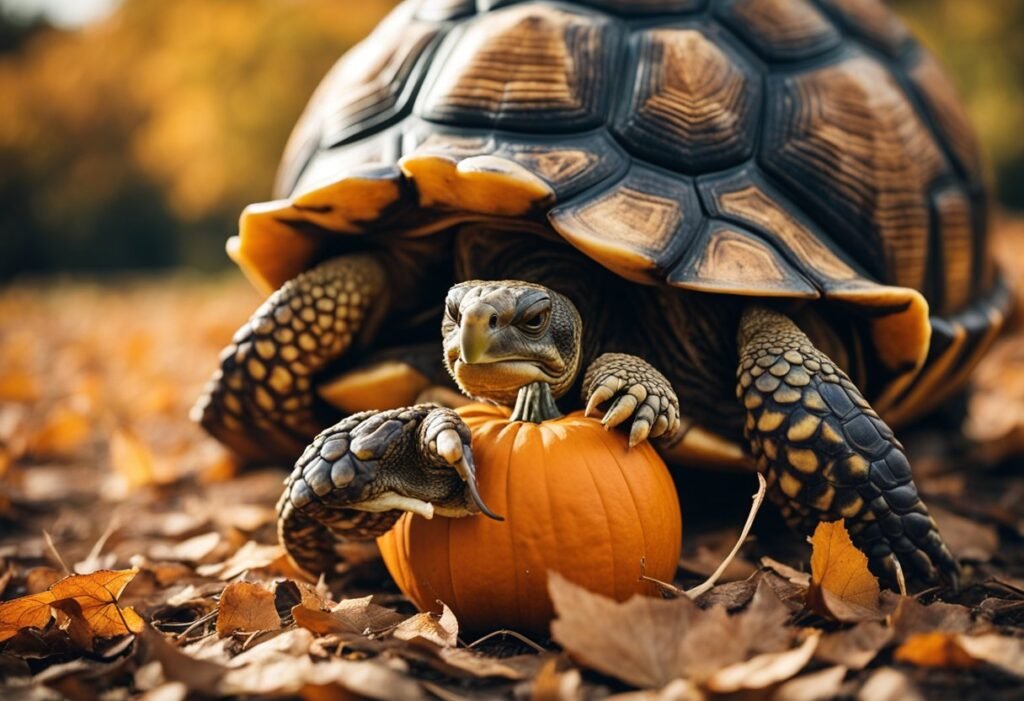
Pumpkin is a popular food for humans during the fall season, but can tortoises eat pumpkin too? In this section, we will explore the nutritional value and digestibility of pumpkin for tortoises.
Nutritional Value of Pumpkin
Pumpkin is a nutrient-rich food that can provide several essential vitamins and minerals for tortoises. Here are some of the key nutrients found in pumpkin:
- Vitamin A: essential for healthy eyesight and immune function
- Vitamin C: important for immune function and collagen production
- Potassium: helps regulate blood pressure and supports healthy muscles and nerves
- Fiber: promotes digestive health and can help prevent constipation
It’s important to note that pumpkin should not be the sole source of these nutrients in a tortoise’s diet. However, it can be a healthy addition in moderation.
Digestibility of Pumpkin
While pumpkin is a nutritious food, it may not be easily digestible for all tortoises. Some tortoises may struggle to break down the tough outer skin of the pumpkin, which could lead to digestive issues.
To make pumpkin more digestible for tortoises, it’s recommended to remove the outer skin and seeds and serve only the flesh. Additionally, pumpkin should be served in small amounts, as overfeeding can cause digestive upset.
In conclusion, pumpkin can be a healthy addition to a tortoise’s diet when served in moderation and prepared properly. It’s important to consider a tortoise’s individual needs and preferences when incorporating new foods into their diet.
Feeding Pumpkin to Tortoises

Pumpkin is a nutritious and tasty food that can be a great addition to a tortoise’s diet. Here are some things to keep in mind when feeding pumpkin to your tortoise.
Preparation Methods
There are several ways to prepare pumpkin for your tortoise. One option is to cut the pumpkin into small pieces and serve it raw. Another option is to cook the pumpkin and then mash it up before serving it to your tortoise. Some tortoise owners also like to mix pumpkin with other vegetables or fruits to create a more varied diet.
When preparing pumpkin for your tortoise, it’s important to remove the seeds and any tough skin. The flesh of the pumpkin is the most nutritious part, and the seeds can be difficult for tortoises to digest. Additionally, the skin of the pumpkin can be tough and difficult for tortoises to chew.
Frequency and Quantity
Pumpkin should be fed to tortoises in moderation. While it can be a healthy addition to their diet, too much pumpkin can lead to digestive issues. We recommend feeding pumpkin to your tortoise no more than once or twice a week.
When feeding pumpkin, it’s important to monitor the quantity. As a general rule, the pumpkin should make up no more than 10% of your tortoise’s overall diet. This ensures that they are getting a balanced diet that includes a variety of other fruits and vegetables.
In conclusion, pumpkin can be a nutritious and tasty addition to your tortoise’s diet when fed in moderation. Remember to prepare it properly and monitor the quantity to ensure your tortoise stays healthy.
Potential Risks and Precautions
Health Risks
While pumpkins can be a healthy addition to a tortoise’s diet, there are some potential health risks to keep in mind. First, pumpkin is high in fiber, which can cause digestive issues if your tortoise eats too much of it. Additionally, pumpkin seeds can contain high levels of fat, which can lead to obesity and other health problems if consumed in large quantities.
To avoid these health risks, we recommend feeding pumpkin to your tortoise in moderation. A good rule of thumb is to offer pumpkin as a treat once or twice a week, and to limit the amount of pumpkin seeds your tortoise consumes.
Signs of Overfeeding
If you do feed your tortoise too much pumpkin, there are a few signs to watch out for. The most common sign of overfeeding is diarrhea, which can be caused by the high fiber content of pumpkin. Additionally, your tortoise may become lethargic or refuse to eat if they are experiencing digestive issues.
To avoid these problems, we recommend monitoring your tortoise closely after feeding them pumpkin. If you notice any signs of digestive distress, reduce the amount of pumpkin you are feeding them and consult with a veterinarian if the symptoms persist.
Overall, while pumpkin can be a healthy addition to a tortoise’s diet, it is important to feed it in moderation and watch for any signs of digestive distress. By taking these precautions, you can help ensure that your tortoise stays happy and healthy.
Alternatives to Pumpkin
When it comes to feeding your tortoise, it’s important to offer a variety of foods to ensure they get all the nutrients they need. While pumpkin is a great option, there are plenty of other foods you can offer your tortoise as well. Here are some alternatives to pumpkin that your tortoise may enjoy:
Other Vegetables
There are plenty of vegetables that are safe and healthy for your tortoise to eat. Some options include:
- Carrots
- Bell peppers
- Squash
- Zucchini
- Kale
- Collard greens
- Mustard greens
- Turnip greens
Make sure to chop the vegetables into small pieces to make them easier for your tortoise to eat.
Fruits
Fruits can be a great addition to your tortoise’s diet, but they should be offered in moderation due to their high sugar content. Some safe options include:
- Apples
- Berries
- Melons
- Papaya
- Mango
- Pineapple
Make sure to remove any seeds or pits before offering fruit to your tortoise.
Protein Sources
Tortoises require a source of protein in their diet, and there are several options that you can offer:
- Cooked chicken or turkey
- Hard boiled eggs
- Tofu
- Insects such as crickets or mealworms
Make sure to offer protein sources in moderation and only as a supplement to your tortoise’s regular diet.
Remember to always research any new food before offering it to your tortoise, and to offer a variety of foods to ensure they get all the nutrients they need.
Frequently Asked Questions

Is pumpkin safe for tortoises to eat?
Yes, pumpkin is safe for tortoises to eat. It is a nutritious vegetable that provides many health benefits for your tortoise.
What are the benefits of feeding pumpkin to tortoises?
Pumpkin is a great source of fiber, which can help keep your tortoise’s digestive system healthy. It also contains many vitamins and minerals, including vitamin A, which is important for maintaining healthy eyesight.
How often should tortoises be fed pumpkin?
Tortoises should be fed pumpkin as a treat, rather than as a regular part of their diet. We recommend feeding pumpkin to your tortoise no more than once or twice a week.
What other vegetables can tortoises eat besides pumpkin?
Tortoises can eat a variety of vegetables, including leafy greens like kale and collard greens, as well as vegetables like carrots, squash, and sweet potatoes.
Can pumpkin be harmful to tortoises if not prepared properly?
Yes, pumpkin can be harmful to tortoises if it is not prepared properly. Make sure to remove the seeds and skin before feeding pumpkin to your tortoise, as these can be difficult for them to digest.
Can canned pumpkin be given to tortoises?
While canned pumpkin is safe for tortoises to eat, it is not recommended. Canned pumpkin often contains added sugars and preservatives, which can be harmful to your tortoise’s health. It is best to stick with fresh pumpkin that has been prepared at home.


